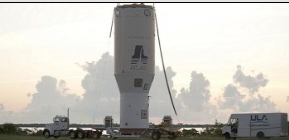[SatNews] The team continues to monitor Tropical Storm Erika in light of the launch scheduled for Monday, August 31...

and everything is progressing toward the MUOS-4 launch for the U.S Navy. The mission is set to lift off on a ULA Atlas V rocket on Monday, August 31 from Space Launch Complex 41 at Cape Canaveral Air Force Station in Florida. The launch window is 6:07-6:51 a.m. EDT.
Weather Forecast
- Launch day overall probability of violating weather constraints: 70 percent Primary concern(s): Cumulus Clouds, Thick Clouds, Ground Winds
- 24-hour delay overall probability of violating weather constraints: 90 percent
- Primary concern(s): Cumulus Clouds, Thick Clouds, Ground Winds
All times eastern daylight time
- Bars and tone – 5:17 A.M.
- Program start –5:47 A.M.
- Launch window – 6:07-6:51 A.M.
- Transmission for digital high definitio
Web cast available at: http://www.ulalaunch.com
United Launch Alliance (ULA) and the U.S. Air Force have demonstrated a commitment to innovation and continuous improvement through implementation of Off-site Vertical Integration (OVI) of several structural elements and the Centaur upper stage for the Atlas V launch vehicle. OVI significantly reduces the number of lifting operations performed at the Vertical Integration Facility (VIF) at Cape Canaveral, taking them off the critical path and allowing for reduced time between launches. Relocating these operations to the Delta Operations Center (DOC), an indoor facility, also mitigates risk of weather-related processing delays.

United Launch Alliance (ULA) has completed its first processing flow utilizing Off-site Vertical Integration (OVI) ahead of the upcoming Atlas V/MUOS-4 mission. The process involves several structural elements – and the Centaur upper stage – being integrated at the indoor Delta Operations Center (DOC) – as opposed to at the pad – potentially shaving a week off flow timelines.
“We are very pleased to have successfully completed the first Off-site Vertical Integration for the upcoming Mobile User Objective System (MUOS) launch. With OVI, the team developed an innovative process that provides safer and more efficient launch processing of the Atlas vehicle.” said Jim Sponnick, ULA vice president, Atlas and Delta Programs. “The associated one-week reduction in the launch-to-launch processing spans enables us to better meet the launch needs of our customers.”
For a 500-series Atlas V rocket like the one launching the MUOS-4 mission, the OVI process accomplishes the integration of six structural elements along with the Centaur upper stage inside a test cell in the DOC, rather than conducting major portions of these complex hardware lifting and mating tasks outside at the VIF. Moving these operations inside provides a safer working environment for employees and mitigates weather impacts to launch schedules. In the last six years, there were 25 days of weather delays to launch vehicle stacking operations at the VIF.
One of the innovations required to enable OVI was the development of a transporter to safely move the five-story stack of rocket hardware approximately six miles from the DOC to the VIF. The transporter includes a tank pressure control system for the Centaur upper stage.
“The Off-site Vertical Integration process, including ground support equipment designs and operational procedures, were developed in collaboration with our Air Force customer to support launch manifest needs and enable continuous improvement to these critical launch operations,” said Sponnick.
Mission Description: The Navy’s Mobile User Objective System (MUOS) is a next-generation narrowband tactical satellite communications system designed using a combination of orbiting satellites and relay ground stations to significantly improve communications for U.S. forces on the move. MUOS will provide new beyond-line-of-sight communications capabilities, with smartphone-like simultaneous voice, video and data – to connect military users almost anywhere around the globe.
Launch Notes: MUOS-4 will mark the 56th Atlas V since the vehicle’s inaugural launch in August 2002 and the sixth in the 551 configuration. Previous missions launched on Atlas V 551 missions include three MUOS missions as well as the New Horizons mission to Pluto and the Juno mission to Jupiter.
“The Air Force is pleased to partner with ULA to find and implement efficiencies. We are fully onboard with efforts to implement continuous process improvement, a key tenant of Better Buying Power 3.0,” said Lt. Gen. Sam Greaves, commander, Space and Missile Systems Center.
ULA's next launch is the MUOS-4 mission for the U.S. Air Force and the U.S. Navy, scheduled to launch August 31 aboard an Atlas V from Space Launch Complex-41 from Cape Canaveral Air Force Station, Florida.
The Evolved Expendable Launch Vehicle (EELV) program was established by the United States Air Force to provide assured access to space for Department of Defense and other government payloads. The commercially developed EELV program supports the full range of government mission requirements while delivering on schedule and providing significant cost savings over the heritage launch systems.
With more than a century of combined heritage, ULA has successfully delivered more than 95 satellites to orbit that provide critical capabilities for troops in the field, aid meteorologists in tracking severe weather, enable personal device-based GPS navigation, and unlock the mysteries of our solar system.

